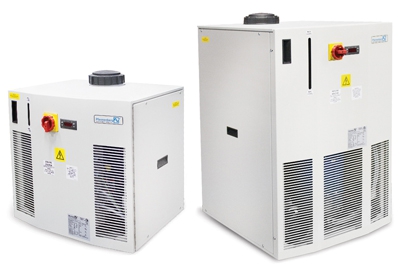
Liquid cooling is considered the most efficient and economical method for removing heat from many types of industrial processes. However, when a local source of cooling water is not feasible, a chiller can provide a convenient, affordable, and sustainable solution. Packaged chillers are complete, turnkey systems for delivering chilled, liquid coolant, which removes excess heat from a process or machine.
Series CC compact packaged chillers from Pfannenberg is comprised of two frame sizes including six different cooling capacities.
Common features include:
• Compressor-based refrigeration system
• Coolant reservoir tank
• Coolant pump
• Finned-tube condenser
• Axial-type condenser fan
• Stainless-steel brazed plate evaporator
• Electronic parametric controller
• UL 508A electrical panel High & low refrigerant pressure switches
• Freeze protection
• Indoor/outdoor IP 54, NEMA 12/4 rated chassis with polyester powder-coated galvanized steel panel construction.
Operating the compact chiller is straightforward. Once the chiller is plumbed to the process, the desired coolant temperature can be set at the controller. The compressor in the refrigeration circuit will cycle on and off as required to maintain the desired coolant temperature. The coolant circulation pump will run continuously, however, an optional bypass flow circuit is available for applications that do not require constant cooling.
Typical applications for the Series CC compact packaged chillers include the following:
• Liquid-cooled variable frequency drives (VFDs)
• Liquid-cooled machine center spindles
• Liquid-cooled cameras and optical equipment
• Liquid-cooled laser and x-ray equipment
• Liquid-cooled chemical reaction vessels and chambers
• Plastic injection molding operations
• High vacuum processes Semiconductor fabrication
Contact Details
Related Glossary Terms
- coolant
coolant
Fluid that reduces temperature buildup at the tool/workpiece interface during machining. Normally takes the form of a liquid such as soluble or chemical mixtures (semisynthetic, synthetic) but can be pressurized air or other gas. Because of water’s ability to absorb great quantities of heat, it is widely used as a coolant and vehicle for various cutting compounds, with the water-to-compound ratio varying with the machining task. See cutting fluid; semisynthetic cutting fluid; soluble-oil cutting fluid; synthetic cutting fluid.






